The satellite of the person in a helmet - the protected Panasonic TOUGHBOOK CF-19 laptop
Preamble
In the previous review, we met with the TOUGHBOOK CF-T8 laptop. The combination of its filling and shell determined the relevance of visiting businessmen. Readers reasonably noticed that the security measures applied in it are not the ultimate dream. This is a reason to talk about the model TOUGHBOOK CF-19, which has a fully protected version (fully-rugged), confirmed by compliance with military and industrial standards.

History of success
Panasonic occupies a niche protected notebook in 1996. The first swallow (model CF-25) quickly multiplies in the environment of corporate and government husbands, whose activities take place far from amenities and safety. In the wake of success, Japanese engineers continue to improve their offspring. Soon "tafbuki" penetrate into the divisions of the US military, police and other urgent urban services. Success in North America contributes to global expansion. Today, Panasonic laptops from a fully protected (fully-rugged) series can be found in the hands of employees of public utilities, law enforcement agencies, employees of exploration, mining, energy, transport and engineering companies.
From revolution to evolution
Exploring the feedback and wishes of users, in 2003, Panasonic expands the family of “tafbooks” with the CF-18, whose display can be rotated 180 degrees, thereby turning the laptop into a compact tablet. We will talk about its modern successor, the CF-19 model (CF-19mk2 or CF-19FHGCXN9), below.
')
Now only a helmet is missing
Touch screen 10.4 ″ XGA with anti-reflective coating
Intel Core 2 Duo U7500 processor
1 GB RAM (expandable to 4 GB)
80 GB SATA Hard Drive
WiFi 802.11 b / g
Bluetooth 2.0 + EDR
1xCOM (RS-232)
3xUSB 2.0
1xIEEE1394a
Modem
Ethernet 10/100/1000
GPS
Weight 2.3 kg
Another possible option in the CF-19 series: HSDPA modem
Complies with US military standard MIL-STD-810F
IP54 protection against moisture and dust
Operating temperature range: from -23 to +60 degrees C
Till 8 business hours from the regular battery
And the full specification from the official website of the manufacturer.
Armor
The laptop case is made of high strength magnesium alloy and reinforced with stiffeners.

According to the manufacturer’s website, a special installation of the main components is implemented inside the case, allowing the laptop to withstand considerable mechanical loads.
US Military Standard Test Report
Information and videos of factory tests:
http://www.panasonic.com/business/toughbook/why-rugged-and-reliable-computers.asp
http://toughbook.ru/tp_technology/MIL_STD_810F
http://toughbook.ru/tp_technology/ip_standart
The hard disk is placed in a metal container, equipped with shock absorbers (dampers), to reduce the impact exerted on it by shock and vibration.

In order to seal the laptop does not use fan cooling - heat is removed from the processor through heat pipes to the surface of the case. Thus, the laptop is devoid of fan holes - the dust is not sucked into the case. Overheating of the case during operation was not observed.
The connectors are closed tightly adjacent rubber covers.

Larger slots are closed by doors. To protect against accidental opening, the lock opens in two directions: first you need to pull the handle to the right ...
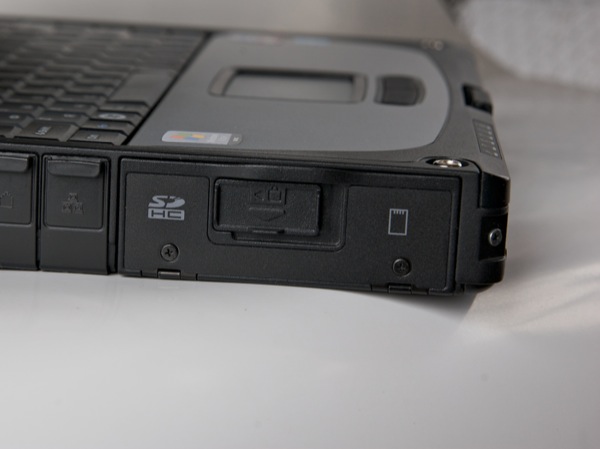

... then down.
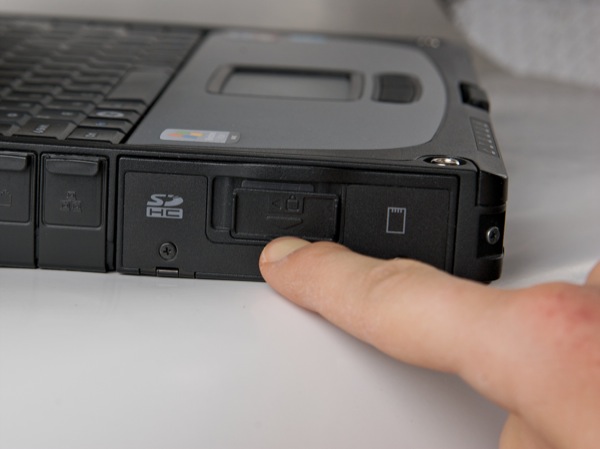
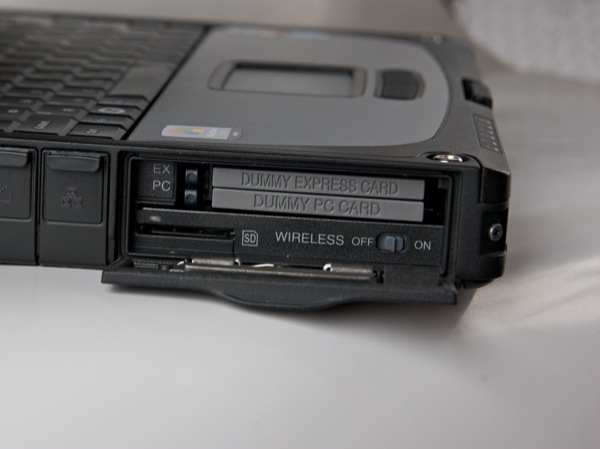
From the inside the door is equipped with a rubber frame for a snug fit to the body.
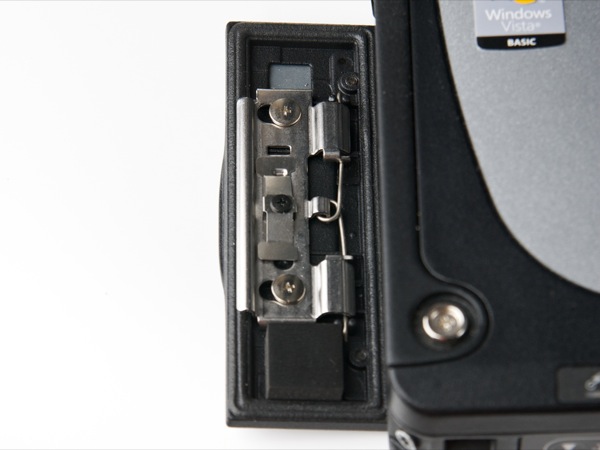
Thus, the laptop case is reliably protected from penetration of small particles of dust and liquid inside. The laptop is suitable for work in many aggressive environments.
On the left side of the case are two USB ports, LAN and modem connectors.
Under the compartment door are PCMCIA and Express Card slots, an SD card slot, and a wireless module switch (allows you to turn off unused modules to reduce power consumption).
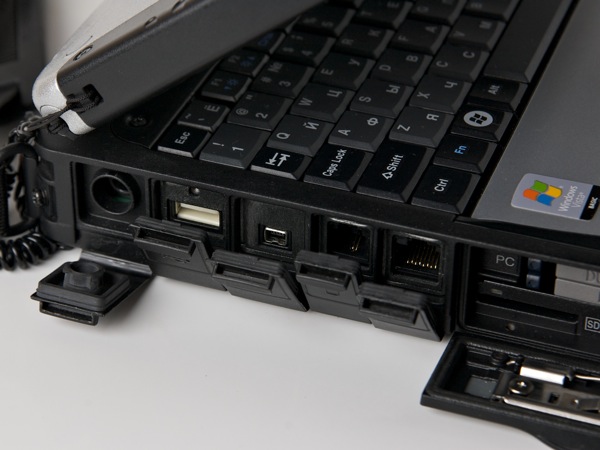
The front panel contains function buttons (from left to right):
decrease and increase the brightness of the screen,
button to call the virtual keyboard / input panel,
Enter button (with a very unobvious pictogram in the form of a dot in the center of the circle),
button to rotate the image on the screen,
button that serves as the keyboard shortcut Ctrl + Alt + Del.
As well as a latch that holds the screen and a button on / off laptop.

On the right panel are two compartments and a GPS antenna.

In the compartments are the battery and hard disk, respectively. They are quick-detachable - a convenient solution when you need to use several sets of batteries and disks alternately.

On the rear panel are audio output, microphone jack, RS-232 serial port, video output - they are also all covered with covers.
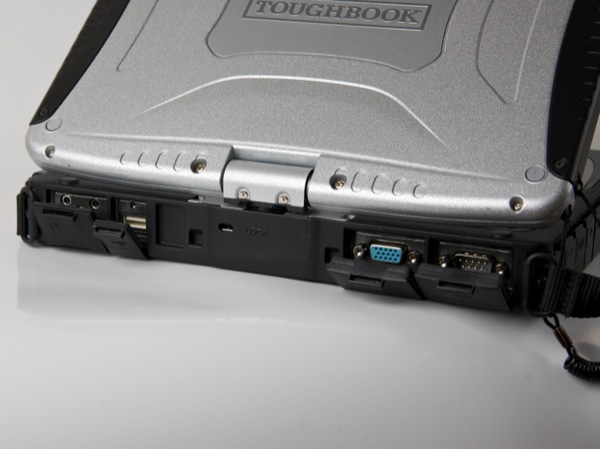
At the bottom of the notebook there is a port for connecting to a docking station with a coaxial connector for external antennas (allowing you to amplify the GPS and HSDPA signal).
Screen
The CF-19 is equipped with a 10.4 ”diagonal screen with a standard resolution of 1024 × 768. The picture quality is also standard, akin to normal screens for “office tasks”. However, the screen has a very bright backlight (500 cd / m2, according to the manufacturer), the effect of which enhances the polarizing coating - the screen almost does not glare, and the image is visible even under direct sunlight. Of course, at the maximum brightness of the backlight, the battery life is reduced, but for comfortable work in the room, the author also had the average level of brightness.
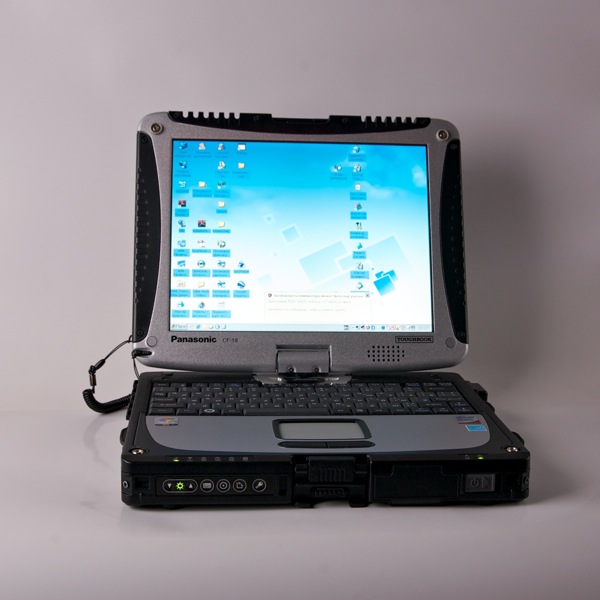
Touch screen, made by resistive technology - this technology does not allow manipulation of several fingers at once. But the screen is “omnivorous”: you can work with it with a stylus or a finger, even if you are wearing gloves.
The screen rotates 180 degrees (you need to pull the lock so that the screen unlocks and it can be rotated).
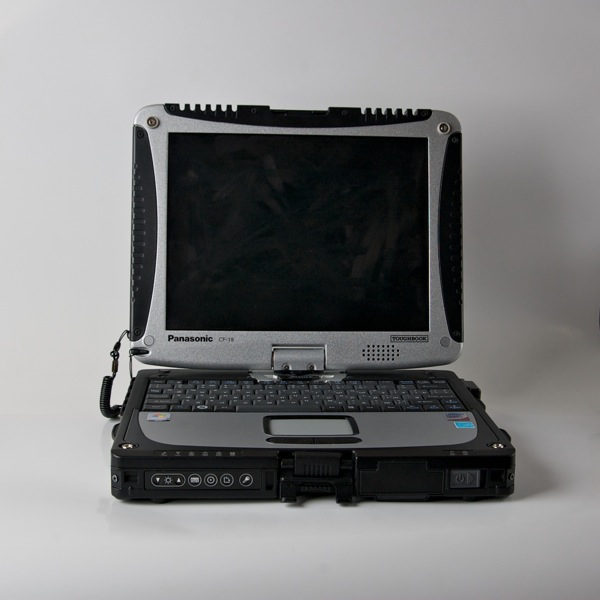

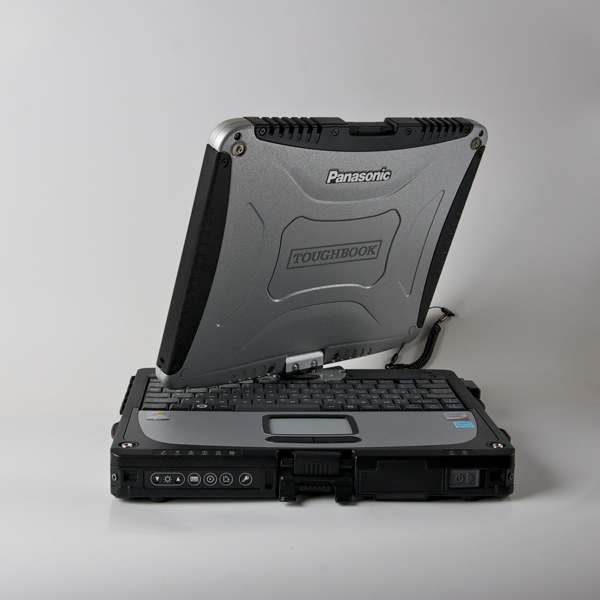
Folded laptop turns into a tablet.
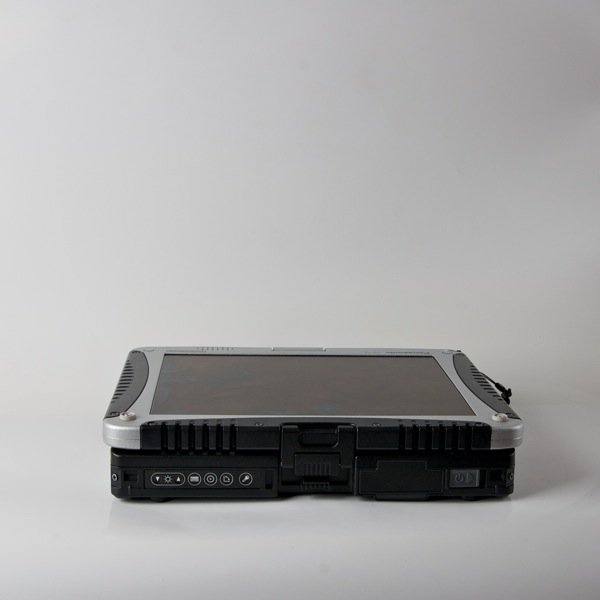
Governing bodies
For convenience, the CF-19's laptop keyboard can be compared to a netbook's keyboard. The keys are pretty tight because of the small size of the laptop. Especially inconvenient seemed grouping keys crosses.
The touchpad is small, rather tight - it requires confident pressure - the cost of security. It is encouraging that the drawbacks of the touchpad partially overlap with a convenient touch screen.
Battery
The laptop uses a lithium-ion battery with a capacity of 5.7 Ah. At room temperature, the laptop worked a little over 8.5 hours (in the mode of medium brightness of the screen, listening to music, browsing the web, working with the table editor, GPS is disabled).

Moisture protection
The IP54 penetration protection level confirms that the laptop is dustproof and also protected from splashes falling in any direction.
Splash protection is not difficult to check in the living conditions.
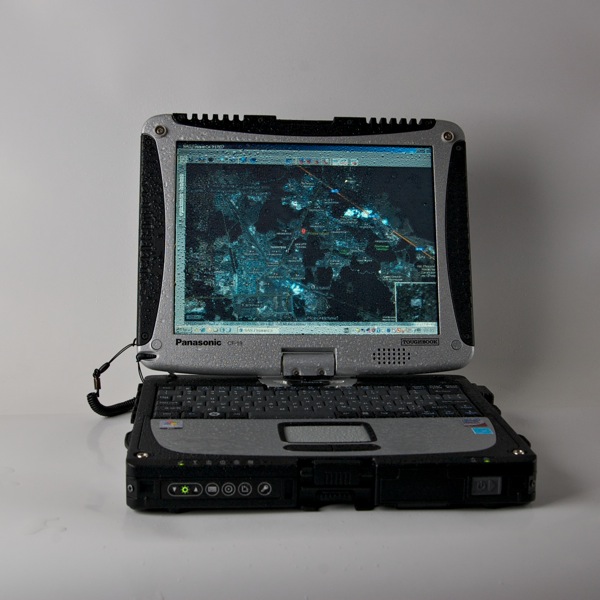
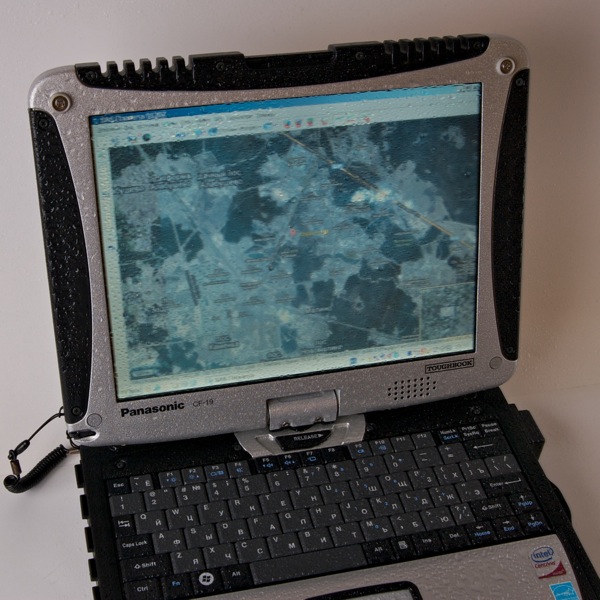


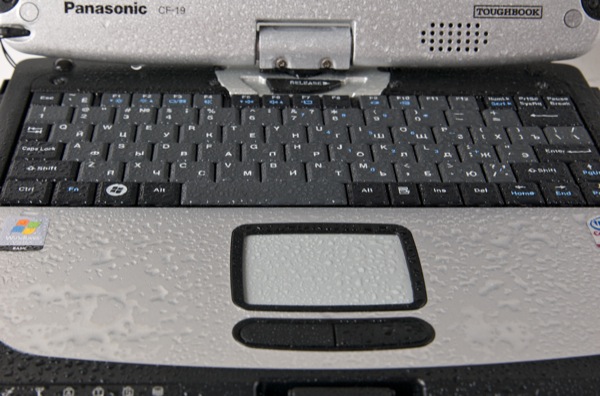
According to the instructions, after work is finished, the wet laptop should be turned off and dried (removing the battery and hard disk from it). So do.
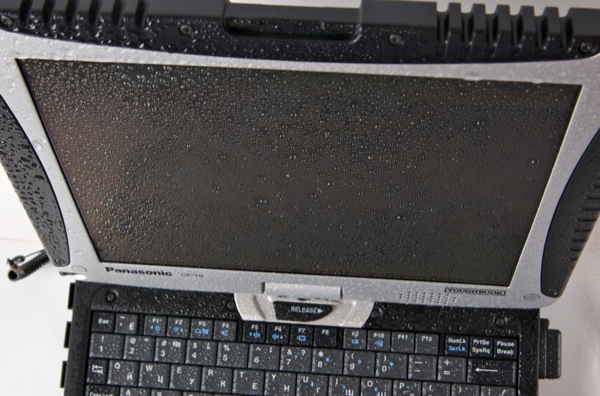
There were no problems or malfunctions.
Work in the cold
According to the test report MIL-STD-810F, the CF-19 laptop operates at a temperature of -23 degrees Celsius. In this case, -10 in the surrounding forest should withstand with ease.
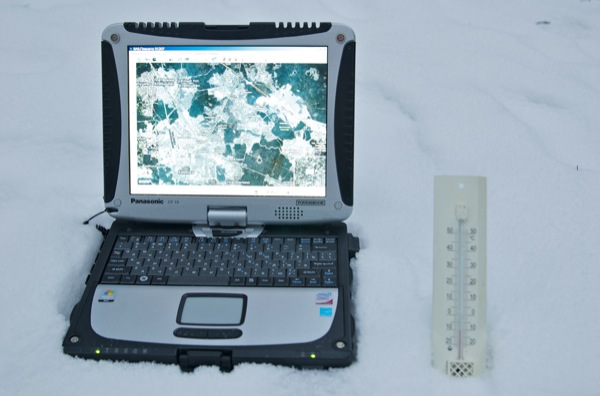
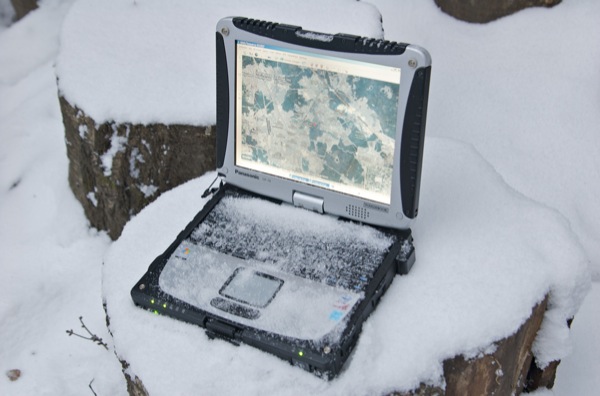
The touch screen works in the cold. And, as from a finger (even in a glove) ...
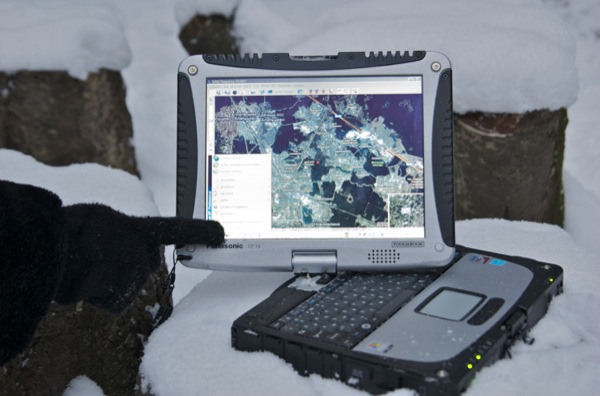
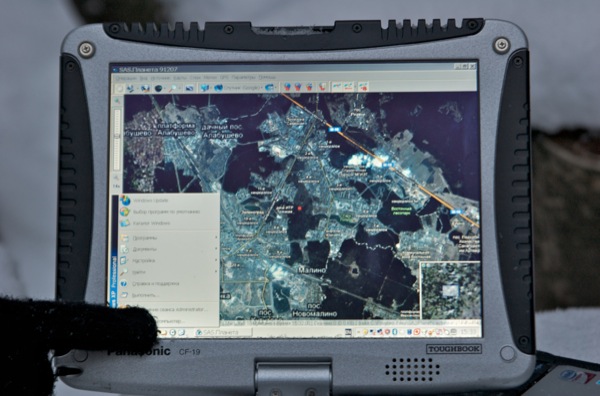
... and from the stylus.

The red dot in the center of the screen is the location on the map determined by the integrated GPS receiver.
Finally
The TOUGHBOOK CF-19 is a niche product that is comparable in price to a premium laptop. In this case, you are investing not in appearance or productivity, but in the security of the transferred data and the possibility of quiet work with them in the most severe conditions. Imagine the sad face of the chief engineer of the oil rig who dropped the laptop with the control software, and you will understand everything.
Source: https://habr.com/ru/post/81114/
All Articles